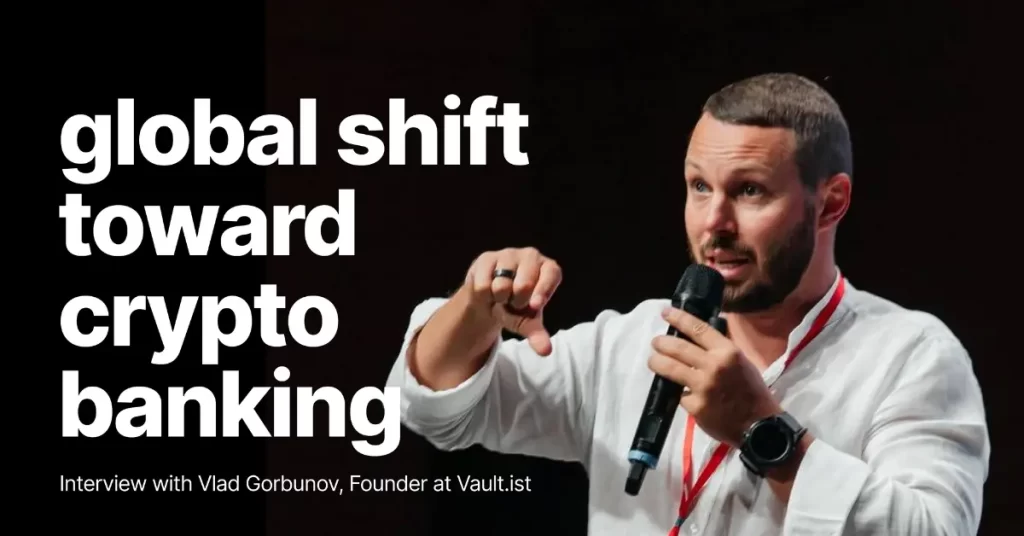ARTICLE AD BOX

The post “As the Crypto Summer Arrives, Projects Fostering Adoption in Non-Financial Sectors Will Rise,” Says Vault Founder Vladimir Gorbunov appeared first on Coinpedia Fintech News
Vladimir Gorbunov, founder of the full-cycle digital/crypto banking white label product Vault, navigated through the intricacies of the rapidly evolving fintech sector and elucidated both the forces propelling its growth and the future it’s hurtling towards.
Today’s fintech industry sees a massive trend of traditional businesses turning their attention to cryptocurrencies. Gorbunov opined that the first layer of this transformation was the remarkable expansion of the crypto market’s audience.
“Back in 2017, we were talking about 10 million active users. Now, we’re looking at nearly half a billion,” he stated, underscoring the magnetic pull this growth exerts on non-crypto companies. “The public interest is especially evident during periods of growth like the looming crypto summer, which is brimming with the potential for earning and the novelty of the products and services offered.”
As per Gorbunov, a burgeoning user base is compelling traditional financial institutions to integrate crypto solutions, a move further incentivized by the modernity, innovation, and flexibility these technologies epitomize.
“They provide access to international capital, asset tokenization opportunities, decentralized insurance, as well as the launch of entire funds and institutions. It’s a vast, unexplored niche with immense potential,” he said.
Delving deeper, Gorbunov illuminated the nuanced motivations behind the shift towards digital/crypto banking.
“But it’s not just about tapping into a new market,” he explained. “It’s about retaining and evolving with your existing audience.” According to Gorbunov, this strategic pivot goes beyond a mere response to market trends; it represents a vital step in staying relevant in an increasingly digital-first economy.
Making Crypto Accessible Beyond the Tech Savvy
Given that more and more retail and institutional investors are rushing into crypto, enticed by alleged profits and technological breakthroughs, the pace of mass adoption is supposed to be accelerating. But Gorbunov remarked that the current infrastructure, primarily restricted to sophisticated crypto banks, still alienates broader audiences, leading to a gap in awareness and trust.
So, his own vision for mainstream crypto centers around accessibility and understanding.
“Bridging this gap,” he suggested, “lies in the hands of traditional banks and fintech companies, who should now start offering crypto services. But before that, they have to adapt crypto products for non-savvies, test market demands, and ensure secure operations.”
Financial institutions, banks, and fintech startups integrate crypto solutions to expand their functionalities. But Gorbunov warned that this process was far more complicated than just adding a crypto wallet or an exchange feature.
In his narrative, companies like Vault emerge to speed things up and provide fintech businesses with the tools to quickly deploy crypto solutions and thereby expand their use cases. In the context of mass adoption, Vault dismantles barriers for a diverse array of entities venturing into digital/crypto banking.
“We’re seeing a radical shift where influencers, bloggers, media, dating services, and other non-financial sectors are eagerly building their digital/crypto solutions,” Gorbunov revealed, highlighting the democratization of financial services.
Then he noted that, for non-financial sector companies, integrating crypto solutions opened new monetization avenues. “However, it’s no longer about making money,” Gorbunov further added.
“With digital/crypto banking functionality now accessible through various API products, modern companies and entrepreneurs can easily customize products and tighten the relationship with their clients through bespoke services, such as branded banking cards that can be topped up with cryptocurrency,” he clarified. “Moreover, they can serve clients globally – something impossible in traditional banking, where operations are confined to the licensing country.”
Looking at adoption from another angle, Gorbunov mentioned that providers of crypto/digital banking infrastructure could draw in new audiences by incentivizing users to promote their solutions together with the companies themselves.
“Vault, for example, relies on the infrastructure of our B2C platform, Choise.com, that has onboarded nearly 1 million users as an accessible entry point into crypto. Many of them have become holders of its native CHO token. And, seeing this, we sat down to consider the possible changes in the project’s tokenomics that would not only benefit our existing supporters but encourage fresh faces to explore the crypto domain brimming with infinite earning possibilities,” he admitted.
From Unregulated Freedom to Global Adoption and Compliance
The conversation then pivoted to a global perspective, with Gorbunov pinpointing regions where digital/crypto banking finds fertile ground. He emphasized a significant surge in demand from areas traditionally underserved by conventional banking and fiat products, such as Latin America, Africa, and specific Asian markets like the Philippines.
Though he stressed that the interest was also significant in strong banking regions like Europe. “In a few years, I expect this geography to expand even more. There will be no specific regional focus, as the demand for digital/crypto banking will become truly global.”
Gorbunov also addressed the international legal landscape, which, in his opinion, underlies the gradual maturity of the crypto market that is shifting towards transparency and compliance. “There was an initial appeal in the unregulated nature of crypto, allowing for freer operation. But it was clear right from the beginning that this lack of governmental control would not last,” he indicated.
Indeed, the centralized crypto market is already highly regulated in many countries through KYC (Know Your Customer) and AML (Anti-Money Laundering) verifications. Whereas, central banks often oversee licensing for virtual asset service providers. And looking forward, Gorbunov anticipates that regulatory strictness will only increase, albeit he sees this potential scrutiny not as a constraint but as a catalyst for sustainable growth and integrity in the sector.
“In fact, the core values of crypto, like tokenization and value transfer, will remain intrinsic,” Gorbunov elaborated. “And for companies with good intentions, increased regulation is beneficial as it establishes clear and transparent rules for all market players.”
But one challenge still lies in regulating decentralized services. Gorbunov acknowledged that many people were flocking to crypto to avoid third-party supervision over their financial operations. Nevertheless, he was firm in his belief that the market would adapt in its DeFi and Web3 sectors.
“There are solutions like Zero-Knowledge protocols that maintain some privacy while ensuring necessary transparency for regulators,” he commented.
The Future of Safe, User-Focused Digital Banking
When asked about the hurdles Vault and other B2B2C companies offering crypto-friendly banking infrastructure encounter today, Gorbunov candidly outlined the steep entry costs and the licensing that remains burdensome, even despite some regulatory frameworks emerging in certain regions.
Also, he dwelled in more detail on the complexity of establishing trustworthy partnerships with card issuers and operation providers like SWIFT and SEPA.
“Although the crypto market is no longer in its early ages, it keeps running into skepticism, often viewed with suspicion of money laundering,” Gorbunov asserted. “We need to constantly justify ourselves with audits and explanations. Finding advanced providers who want to integrate with you, understand the mix of crypto and fiat transactions, and offer this to a wide audience, including external players, is a complex task that requires much effort and investment.”
In his closing thoughts, Gorbunov offered a glimpse into the future. “We’re at a pivotal moment where traditional and crypto finance are converging,” he claimed.
Gorbunov envisions a world rich with tokenized assets and creative works, echoing another big crypto trend dubbed “Real-World Assets,” or RWAs. From his point of view, the development of digital/crypto banking will be driven by a balanced blend of decentralized and centralized financial systems.
“It’s about giving control back to the people in a safe and user-friendly environment,” Gorbunov concluded.
Through Gorbunov’s insights, the path forward in fintech, and digital and crypto banking in particular, becomes clearer: a blend of innovation, adaptation, and expansive reach, with Vault pioneering at the helm and guiding the way towards a more inclusive and dynamic financial future.
.png)
 9 months ago
2
9 months ago
2








 English (US)
English (US)